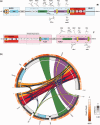Structure, transcription, and variability of metazoan mitochondrial genome: perspectives from an unusual mitochondrial inheritance system
- PMID: 23882128
- PMCID: PMC3762199
- DOI: 10.1093/gbe/evt112
Structure, transcription, and variability of metazoan mitochondrial genome: perspectives from an unusual mitochondrial inheritance system
Abstract
Despite its functional conservation, the mitochondrial genome (mtDNA) presents strikingly different features among eukaryotes, such as size, rearrangements, and amount of intergenic regions. Nonadaptive processes such as random genetic drift and mutation rate play a fundamental role in shaping mtDNA: the mitochondrial bottleneck and the number of germ line replications are critical factors, and different patterns of germ line differentiation could be responsible for the mtDNA diversity observed in eukaryotes. Among metazoan, bivalve mollusc mtDNAs show unusual features, like hypervariable gene arrangements, high mutation rates, large amount of intergenic regions, and, in some species, an unique inheritance system, the doubly uniparental inheritance (DUI). The DUI system offers the possibility to study the evolutionary dynamics of mtDNAs that, despite being in the same organism, experience different genetic drift and selective pressures. We used the DUI species Ruditapes philippinarum to study intergenic mtDNA functions, mitochondrial transcription, and polymorphism in gonads. We observed: 1) the presence of conserved functional elements and novel open reading frames (ORFs) that could explain the evolutionary persistence of intergenic regions and may be involved in DUI-specific features; 2) that mtDNA transcription is lineage-specific and independent from the nuclear background; and 3) that male-transmitted and female-transmitted mtDNAs have a similar amount of polymorphism but of different kinds, due to different population size and selection efficiency. Our results are consistent with the hypotheses that mtDNA evolution is strongly dependent on the dynamics of germ line formation, and that the establishment of a male-transmitted mtDNA lineage can increase male fitness through selection on sperm function.
Keywords: CORR; doubly uniparental inheritance; germ line mitochondria; mitochondrial intergenic regions; mitochondrial polymorphism; novel mitochondrial ORFs.
Figures






References
-
- Abhishek A, Bavishi A, Bavishi A, Choudhary M. Bacterial genome chimaerism and the origin of mitochondria. Can J Microbiol. 2011;57:49–46. - PubMed
-
- Allen JF. Separate sexes and the mitochondrial theory of ageing. J Theor Biol. 1996;180:135–140. - PubMed
-
- Allendorf FW. Genetic drift and the loss of alleles versus heterozygosity. Zool Biol. 1986;5:181–190.
-
- Andersson SG, Kurland CG. Reductive evolution of resident genomes. Trends Microbiol. 1998;6:263–268. - PubMed
Publication types
MeSH terms
Substances
Associated data
- Actions
- Actions
- Actions
- Actions
- Actions
- Actions
- Actions
- Actions
- Actions
- Actions
- Actions
- Actions
- Actions
- Actions
- Actions
- Actions
- Actions
- Actions
- Actions
- Actions
- Actions
- Actions
- Actions
- Actions
- Actions
- Actions
- Actions
- Actions
- Actions
- Actions
Grants and funding
LinkOut - more resources
Full Text Sources
Other Literature Sources

